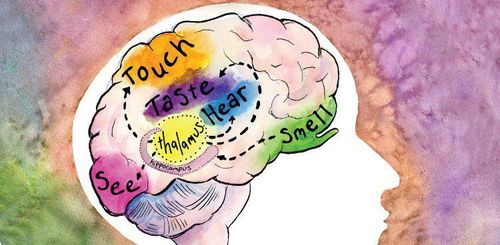This is an automatically translated article.
The article is professionally consulted by Master, Doctor Nguyen Thi An - Pediatrician - Neonatologist - Department of Pediatrics - Neonatology - Vinmec Ha Long International HospitalRight from the time we were in the womb, the taste buds of the tongue were formed and gave us our first taste experiences. The formation and development of taste is a process that helps people explore and enjoy many different dishes, and stimulates the perfection of taste buds and other body senses.
1. How is the taste of the tongue formed?
In general, the taste buds on the tongue are formed and developed right from the time the baby is in the womb. The surface of the tongue is covered with taste buds, which contain taste organs and a number of glands that help create and secrete saliva. There are actually four types of taste buds of different shapes and sizes on certain areas of the tongue.The taste buds on the tongue are a combination of cells, including basal cells, columnar cells and 10-50 taste receptor cells, which are renewed every 5 - 10 days. Some of these receptor cells contain proteins that, on their surfaces, bind to chemicals from the foods you consume, while others have ion channels activated by various chemicals. . When the receptor detects a specific chemical, this information is transmitted along a series of nerve pathways to the brain, where the tongue's taste buds are perceived.
For the fetus while in the womb, the baby will swallow amniotic fluid and develop the digestive system. The flavors in the foods the mother consumes pass through the bloodstream into the amniotic fluid. When drinking amniotic fluid, the taste buds on the baby's tongue will have the first experience of different flavors.
After the baby is born, the taste buds of the tongue are now very sensitive and can already perceive sour and sweet flavors. However, babies tend to prefer sweet flavors. This is also the reason why babies love the taste of breast milk. It's not until babies are about 5 months old that their taste buds develop responses to salty foods.
2. What is the function of taste?

Vị giác của lưỡi đóng vai trò giúp bạn nhận biết mùi vị
The physical process of taste starts at the surface of the tongue, where the taste buds are located inside the taste buds, which cover your tongue. These taste buds are composed of many different cells, of which only taste receptor cells can develop their ability to perceive taste.
Tongue is a taste receptor, made up of muscle fibers, including the following parts:
Tongue body: Located in front, can move flexibly back and forth, up and down. The base of the tongue: Located posteriorly, connected to the roof of the mouth and the hyoid bone. Upper surface of tongue: Consists of many taste nerve spines with taste buds scattered in between the grooves of the tongue. The tongue holds 4 important functions, including: tasting, swallowing, chewing and speaking. Tongue helps you perceive the taste of food and water through taste in the tongue (one of the 5 essential senses of the body).
Taste buds of the tongue (taste buds) are located in certain areas on the surface of the tongue. Specifically, the sour and salty taste buds are located on the sides of the tongue, the sweet taste buds are located at the tip of the tongue, and the bitter taste buds are located at the back of the tongue. Even on the underside of the tongue, including the throat and palate, there are also a few taste buds, so you can still feel the taste of food through them.
On the other hand, in each taste bud there are thousands of different taste cells, so when stimulated by chemicals in drinking water and food, they will transmit taste along nerves to the brain to help you distinguish the taste of food.
3. The connection of taste with other senses

Gai vị giác ở lưỡi kết hợp với mũi giúp bạn nhân biết hoàn chỉnh các hương vị món ăn
When you eat spicy food, actually the taste buds on the tongue do not work, instead, the touch helps you react to the hot spicy food that the food causes. On the other hand, the nose is also associated with taste, contributing to your taste perception. In addition, the sense of smell is also involved in the perception of taste when you smell food. To enhance the taste when chewing, the organs associated with the nose located at the back of the mouth stimulate the sense of smell strongly.
In the absence of other senses, your body still has the ability to use taste on the tongue, but this will cause the taste experience to be significantly lost.
In the brain, the information received from the senses will be synthesized to be able to create a perception of the taste of your food. Electrical impulses representing smell, taste and touch are sent to the right parts of the brain for decoding.
The electrical impulses from the last taste buds of the tongue will be processed when they reach the cerebral cortex, while other parts of the brain will receive information from touch and smell, thereby putting together a " complete picture of the taste of the dish.
For young children, the formation and development of taste and other body senses from the very beginning is a very important thing. After birth, a baby's taste buds are very sensitive and develop rapidly. Therefore, right from the first years of life, parents need to pay attention to supplementing with adequate nutrients, helping the baby develop taste as well as other senses smoothly.
Parents should supplement their children with supportive products containing lysine, essential micro-minerals and vitamins such as zinc, chromium, selenium, and B vitamins to help fully meet their child's nutritional needs. At the same time, these essential vitamins also support digestion, enhance nutrient absorption, help improve anorexia, and help children eat well.
Parents can learn more:
Signs of zinc deficiency in children
Micronutrient deficiency and failure to gain weight in children
To learn more about taking care of children at each age, visit regularly Visit the website (vinmec.com) and book an appointment with the leading doctors, pediatric experts - Nutrition when you need advice.
References: science.org.au, ncbi.nlm.nih.gov













